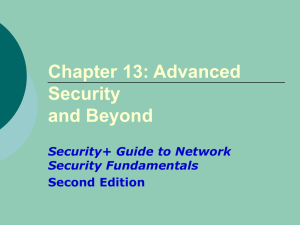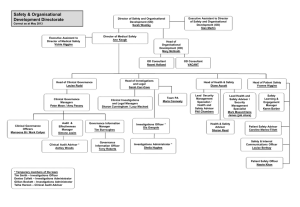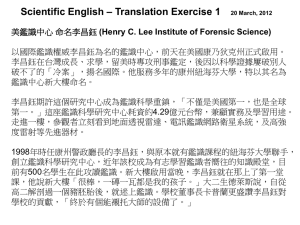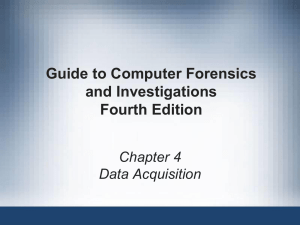Chapter 9
advertisement
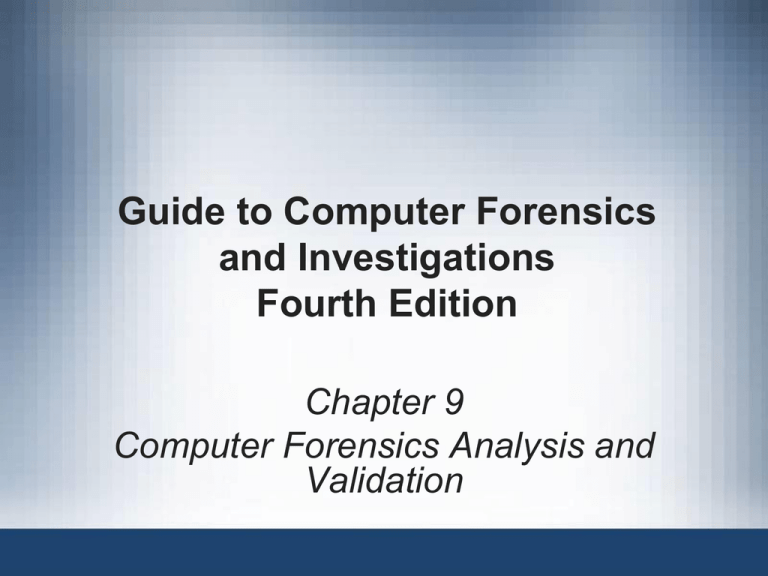
Guide to Computer Forensics and Investigations Fourth Edition Chapter 9 Computer Forensics Analysis and Validation Objectives • Determine what data to analyze in a computer forensics investigation • Explain tools used to validate data • Explain common data-hiding techniques Guide to Computer Forensics and Investigations 2 Determining What Data to Collect and Analyze • Examining and analyzing digital evidence depends on: – – – – Nature of the case Amount of data to process Search warrants and court orders Company policies • Scope creep – Investigation expands beyond the original description • Right of full discovery of digital evidence Guide to Computer Forensics and Investigations 3 Approaching Computer Forensics Cases • Some basic principles apply to almost all computer forensics cases – The approach you take depends largely on the specific type of case you’re investigating • Basic steps for all computer forensics investigations – For target drives, use only recently wiped media that have been reformatted • And inspected for computer viruses Guide to Computer Forensics and Investigations 4 Approaching Computer Forensics Cases (continued) • Basic steps for all computer forensics investigations (continued) – Inventory the hardware on the suspect’s computer and note the condition of the computer when seized – Remove the original drive from the computer • Check date and time values in the system’s CMOS – Record how you acquired data from the suspect drive – Process the data methodically and logically Guide to Computer Forensics and Investigations 5 Approaching Computer Forensics Cases (continued) • Basic steps for all computer forensics investigations (continued) – List all folders and files on the image or drive – If possible, examine the contents of all data files in all folders • Starting at the root directory of the volume partition – For all password-protected files that might be related to the investigation • Make your best effort to recover file contents Guide to Computer Forensics and Investigations 6 Approaching Computer Forensics Cases (continued) • Basic steps for all computer forensics investigations (continued) – Identify the function of every executable (binary or .exe) file that doesn’t match known hash values – Maintain control of all evidence and findings, and document everything as you progress through your examination Guide to Computer Forensics and Investigations 7 Refining and Modifying the Investigation Plan • Considerations – – – – Determine the scope of the investigation Determine what the case requires Whether you should collect all information What to do in case of scope creep • The key is to start with a plan but remain flexible in the face of new evidence Guide to Computer Forensics and Investigations 8 Validating Forensic Data • One of the most critical aspects of computer forensics • Ensuring the integrity of data you collect is essential for presenting evidence in court • Most computer forensic tools provide automated hashing of image files • Computer forensics tools have some limitations in performing hashing – Learning how to use advanced hexadecimal editors is necessary to ensure data integrity Guide to Computer Forensics and Investigations 9 Validating with Hexadecimal Editors • Advanced hexadecimal editors offer many features not available in computer forensics tools – Such as hashing specific files or sectors • Hex Workshop provides several hashing algorithms – Such as MD5 and SHA-1 – See Figures 9-4 through 9-6 • Hex Workshop also generates the hash value of selected data sets in a file or sector Guide to Computer Forensics and Investigations 10 Validating with Hexadecimal Editors (continued) Guide to Computer Forensics and Investigations 11 Validating with Hexadecimal Editors (continued) Guide to Computer Forensics and Investigations 12 Validating with Hexadecimal Editors (continued) Guide to Computer Forensics and Investigations 13 Validating with Hexadecimal Editors (continued) • Using hash values to discriminate data – AccessData has a separate database, the Known File Filter (KFF) • Filters known program files from view, such as MSWord.exe – KFF compares known file hash values to files on your evidence drive or image files – Periodically, AccessData updates these known file hash values and posts an updated KFF Guide to Computer Forensics and Investigations 14 Validating with Computer Forensics Programs • Commercial computer forensics programs have built-in validation features • ProDiscover’s .eve files contain metadata that includes the hash value – Validation is done automatically • Raw format image files (.dd extension) don’t contain metadata – So you must validate raw format image files manually to ensure the integrity of data Guide to Computer Forensics and Investigations 15 Validating with Computer Forensics Programs (continued) • In AccessData FTK Imager – When you select the Expert Witness (.e01) or the SMART (.s01) format • Additional options for validating the acquisition are displayed – Validation report lists MD5 and SHA-1 hash values Guide to Computer Forensics and Investigations 16 Addressing Data-hiding Techniques • File manipulation – Filenames and extensions – Hidden property • Disk manipulation – Hidden partitions – Bad clusters • Encryption – Bit shifting – Steganography Guide to Computer Forensics and Investigations 17 Hiding Partitions • Delete references to a partition using a disk editor – Re-create links for accessing it • Use disk-partitioning utilities – – – – GDisk PartitionMagic System Commander LILO • Account for all disk space when analyzing a disk Guide to Computer Forensics and Investigations 18 Hiding Partitions (continued) Guide to Computer Forensics and Investigations 19 Hiding Partitions (continued) Guide to Computer Forensics and Investigations 20 Marking Bad Clusters • • • • Common with FAT systems Place sensitive information on free space Use a disk editor to mark space as a bad cluster To mark a good cluster as bad using Norton Disk Edit – Type B in the FAT entry corresponding to that cluster Guide to Computer Forensics and Investigations 21 Bit-shifting • • • • Old technique Shift bit patterns to alter byte values of data Make files look like binary executable code Tool – Hex Workshop Guide to Computer Forensics and Investigations 22 Bit-shifting (continued) Guide to Computer Forensics and Investigations 23 Bit-shifting (continued) Guide to Computer Forensics and Investigations 24 Bit-shifting (continued) Guide to Computer Forensics and Investigations 25 Using Steganography to Hide Data • Greek for “hidden writing” • Steganography tools were created to protect copyrighted material – By inserting digital watermarks into a file • Suspect can hide information on image or text document files – Most steganography programs can insert only small amounts of data into a file • Very hard to spot without prior knowledge • Tools: S-Tools, DPEnvelope, jpgx, and tte Guide to Computer Forensics and Investigations 26 Examining Encrypted Files • Prevent unauthorized access – Employ a password or passphrase • Recovering data is difficult without password – Key escrow • Designed to recover encrypted data if users forget their passphrases or if the user key is corrupted after a system failure – Cracking password • Expert and powerful computers – Persuade suspect to reveal password Guide to Computer Forensics and Investigations 27 Recovering Passwords • Techniques – Dictionary attack – Brute-force attack – Password guessing based on suspect’s profile • Tools – AccessData PRTK – Advanced Password Recovery Software Toolkit – John the Ripper Guide to Computer Forensics and Investigations 28 Recovering Passwords (continued) • Using AccessData tools with passworded and encrypted files – AccessData offers a tool called Password Recovery Toolkit (PRTK) • Can create possible password lists from many sources – Can create your own custom dictionary based on facts in the case – Can create a suspect profile and use biographical information to generate likely passwords Guide to Computer Forensics and Investigations 29 Recovering Passwords (continued) • Using AccessData tools with passworded and encrypted files (continued) – FTK can identify known encrypted files and those that seem to be encrypted • And export them – You can then import these files into PRTK and attempt to crack them Guide to Computer Forensics and Investigations 30 Summary • Examining and analyzing digital evidence depends on the nature of the investigation and the amount of data you have to process • For most computer forensics investigations, you follow the same general procedures • One of the most critical aspects of computer forensics is validating digital evidence • Data hiding involves changing or manipulating a file to conceal information Guide to Computer Forensics and Investigations 31

